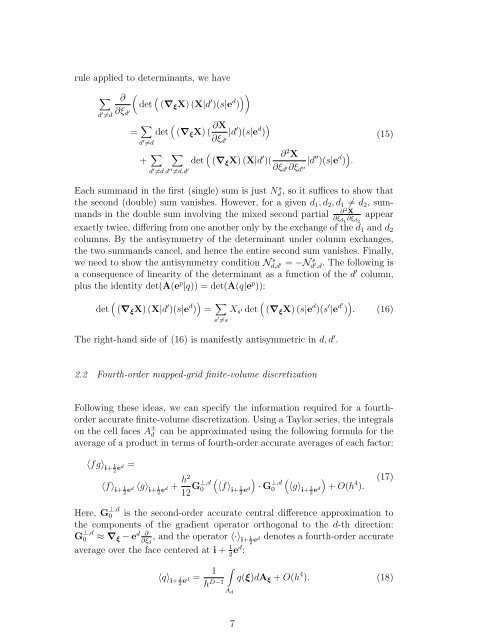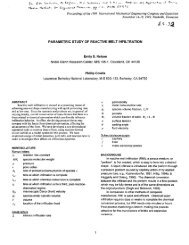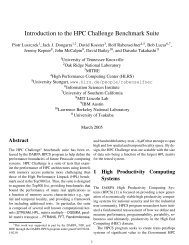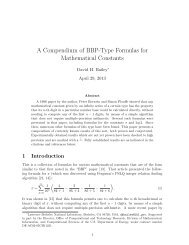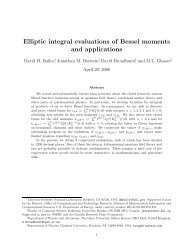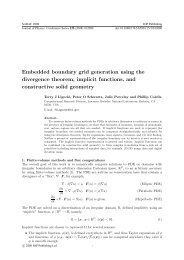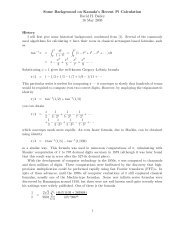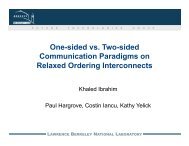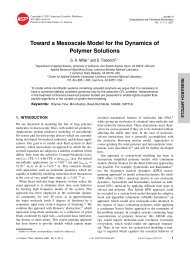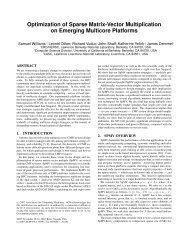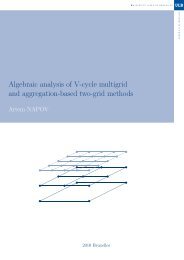High-Order, Finite-Volume Methods in Mapped Coordinates
High-Order, Finite-Volume Methods in Mapped Coordinates
High-Order, Finite-Volume Methods in Mapped Coordinates
You also want an ePaper? Increase the reach of your titles
YUMPU automatically turns print PDFs into web optimized ePapers that Google loves.
ule applied to determ<strong>in</strong>ants, we have∑∂(det ( (∇ ξ X) (X|d ′ )(s|e d ) ))d ′ ≠d∂ξ d ′= ∑ det ( (∇ ξ X) ( ∂X |d ′ )(s|e d ) )∂ξd ′ ≠dd ′+ ∑ ∑det ( (∇ ξ X) (X|d ′ ∂ 2 X)( |d ′′ )(s|e d ) ) .∂ξd ′ ≠d d ′′ ≠d,d ′ d ′∂ξ d ′′(15)Each summand <strong>in</strong> the first (s<strong>in</strong>gle) sum is just Nd, s so it suffices to show thatthe second (double) sum vanishes. However, for a given d 1 , d 2 , d 1 ≠ d 2 , summands<strong>in</strong> the double sum <strong>in</strong>volv<strong>in</strong>g the mixed second partial2 X ∂∂ξ d1 ∂ξ d2appearexactly twice, differ<strong>in</strong>g from one another only by the exchange of the d 1 and d 2columns. By the antisymmetry of the determ<strong>in</strong>ant under column exchanges,the two summands cancel, and hence the entire second sum vanishes. F<strong>in</strong>ally,we need to show the antisymmetry condition Nd,d s = −N s ′ d ,d. The follow<strong>in</strong>g is′a consequence of l<strong>in</strong>earity of the determ<strong>in</strong>ant as a function of the d ′ column,plus the identity det(A(e p |q)) = det(A(q|e p )):det ( (∇ ξ X) (X|d ′ )(s|e d ) ) = ∑ s ′ ≠sX s ′ det ( (∇ ξ X) (s|e d )(s ′ |e d′ ) ) . (16)The right-hand side of (16) is manifestly antisymmetric <strong>in</strong> d, d ′ .2.2 Fourth-order mapped-grid f<strong>in</strong>ite-volume discretizationFollow<strong>in</strong>g these ideas, we can specify the <strong>in</strong>formation required for a fourthorderaccurate f<strong>in</strong>ite-volume discretization. Us<strong>in</strong>g a Taylor series, the <strong>in</strong>tegralson the cell faces A ± d can be approximated us<strong>in</strong>g the follow<strong>in</strong>g formula for theaverage of a product <strong>in</strong> terms of fourth-order accurate averages of each factor:〈fg〉 i+12 ed =〈f〉 i+1 〈g〉2 ed i+1 + h22 ed 12 G⊥,d 0( ) ( )〈f〉i+ 1 · G⊥,d2 ed 0 〈g〉i+ 1 + O(h 4 ).2 ed(17)Here, G ⊥,d0 is the second-order accurate central difference approximation tothe components of the gradient operator orthogonal to the d-th direction:G ⊥,d0 ≈ ∇ ξ − e d ∂∂ξ d, and the operator 〈·〉 i+1 denotes a fourth-order accurateed2average over the face centered at i + 1 2 ed :〈q〉 i+1 = 1 ∫2 ed h D−1A dq(ξ)dA ξ + O(h 4 ). (18)7


